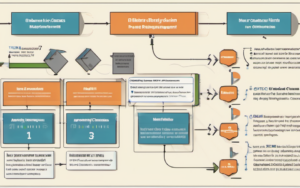The rise of blockchain technology has sparked intense debate about its potential to revolutionize various industries, and the financial sector is no exception. Many wonder if blockchain banks will eventually render traditional banks obsolete. While the technology presents exciting possibilities, a complete replacement is unlikely in the near future. Let’s explore the potential and limitations of blockchain in the banking landscape.
1. Introduction
1.1 The Promise of Decentralization
Blockchain technology, at its core, promises a decentralized system. Unlike traditional banking, which relies on centralized intermediaries like banks to process transactions, blockchain utilizes a distributed ledger. This means that transaction records are shared across a network of computers, eliminating the need for a central authority to validate and verify transactions. This inherent decentralization is a key appeal for those exploring the potential of blockchain banks, promising greater transparency and potentially lower costs. The concept is intriguing, offering a stark contrast to the established hierarchical structure of the current banking system.
1.2 The Current Role of Banks
Banks play a crucial role in the modern financial ecosystem. They provide essential services including account management, loan processing, payment processing, and risk management. These services are deeply ingrained in our economic infrastructure, offering a level of trust and stability that underpins much of our daily lives. While blockchain offers innovative solutions, it’s important to acknowledge the critical functions that traditional banks currently perform and the established trust they enjoy amongst consumers and businesses. The question isn’t simply about replacement, but rather integration and evolution.
2. Blockchain Technology and its Potential
2.1 Decentralized Finance (DeFi) Explained
Decentralized finance (DeFi) is a rapidly growing sector built on blockchain technology. DeFi aims to create financial products and services without relying on traditional intermediaries. This includes decentralized lending platforms, exchanges, and stablecoins. The potential impact of DeFi on the banking industry is significant, as it offers alternative ways to access financial services, potentially bypassing traditional banks entirely for certain transactions. However, DeFi still faces challenges in terms of regulation, security, and user experience.
2.2 Smart Contracts and Automation
Smart contracts are self-executing contracts with the terms of the agreement directly written into code. This automation can streamline various banking processes, from loan disbursement to fraud detection. Blockchain banks can potentially leverage smart contracts to enhance efficiency and reduce the need for human intervention. This leads to faster transaction times and lower operational costs, though the implementation and integration of smart contracts require careful consideration of legal and technical complexities.
2.3 Enhanced Security and Transparency
Blockchain’s inherent transparency and cryptographic security features offer significant advantages over traditional banking systems. The immutable nature of the blockchain makes it extremely difficult to alter transaction records, reducing the risk of fraud and data breaches. This enhanced security and transparency could significantly improve trust in financial systems, benefiting both consumers and businesses. The increased transparency, however, also requires careful consideration of data privacy issues.
3. Challenges and Limitations of Blockchain Adoption
3.1 Scalability Issues and Transaction Speeds
One major hurdle for widespread blockchain adoption in banking is scalability. Current blockchain networks struggle to handle the high volume of transactions processed by traditional banking systems. Transaction speeds are also relatively slow compared to established payment rails. Improvements in blockchain technology are addressing these scalability challenges, but it’s a complex issue that needs ongoing innovation. Many are working on solutions like layer-2 scaling solutions to address these limitations.
3.2 Regulatory Uncertainty and Compliance
The regulatory landscape surrounding blockchain technology remains uncertain in many jurisdictions. This uncertainty makes it difficult for banks and financial institutions to integrate blockchain into their operations. The lack of clear regulatory frameworks can also hinder innovation and create barriers to entry for new blockchain-based financial services. Understanding and complying with existing and evolving regulations will be crucial for the successful adoption of blockchain in banking.
3.3 User Experience and Accessibility
The user experience for interacting with blockchain-based financial services can be complex and challenging for non-technical users. The technical barriers to entry, particularly for users unfamiliar with cryptographic concepts, can limit the widespread adoption of blockchain banks. Improving user experience and accessibility is critical for mass adoption. Simplifying the user interface and providing user-friendly tools will be essential for attracting a wider range of users.
3.4 Security Risks and Vulnerabilities
While blockchain offers enhanced security features, it is not without its vulnerabilities. Smart contract vulnerabilities, for example, can be exploited by hackers, potentially leading to significant financial losses. Moreover, the decentralized nature of blockchain can make it more challenging to track and recover funds in the event of a security breach. Robust security protocols and ongoing security audits are essential to mitigate these risks.
4. The Future of Banking: A Hybrid Model?
4.1 Collaboration Between Banks and Blockchain
Rather than complete replacement, a more likely scenario involves collaboration between traditional banks and blockchain technology. Banks can leverage blockchain to improve efficiency, enhance security, and offer new financial products and services. This hybrid model allows banks to benefit from the advantages of blockchain while retaining the existing infrastructure and regulatory frameworks. This collaborative approach harnesses the strengths of both systems.
4.2 Integration of Blockchain into Existing Systems
Integrating blockchain technology into existing banking systems is a complex undertaking, requiring significant investment in infrastructure and expertise. This integration will likely be a gradual process, with banks initially focusing on specific applications, such as cross-border payments or supply chain finance, before extending the use of blockchain to other areas of their operations. A phased approach minimizes disruption and allows for iterative improvements.
4.3 The Rise of Fintech and its Impact
The rise of fintech companies specializing in blockchain-based financial services is further reshaping the banking landscape. These companies are driving innovation and pushing the boundaries of what’s possible with blockchain technology. The competition from fintech companies is forcing traditional banks to adapt and innovate, leading to greater integration of blockchain and other emerging technologies. This competitive landscape fosters innovation and drives efficiency improvements.
5. Coexistence Rather Than Replacement
The evolving relationship between blockchain and traditional banking is best described as coexistence rather than replacement. While blockchain offers compelling advantages in terms of efficiency, transparency, and security, it also faces significant challenges in terms of scalability, regulation, and user experience. Traditional banks will continue to play a vital role in the financial system, providing essential services and maintaining stability. However, the integration of blockchain technology will undoubtedly transform the banking industry, leading to more efficient, secure, and customer-centric financial services. The long-term implications for consumers and businesses include greater access to financial services, lower costs, and enhanced security. The future of finance will likely be a hybrid model, leveraging the strengths of both traditional banking and blockchain technology.




